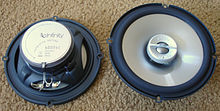Coaxial speakers
A coaxial loudspeaker (also known as a coax chassis ) is a loudspeaker in which several sound-radiating units are concentrically nested. Converters specialized in different frequency ranges are positioned along the same acoustic axis (coaxial).
Working principle

The entire human hearing spectrum is difficult to reproduce with a single loudspeaker, as the shape and size of the membrane influence the linearly reproducible frequency spectrum, the attainable volume and the respective radiation angle - problems with which all broadband loudspeakers have to struggle. For this reason, in HiFi - boxes usually used several speakers. Such reusable systems irritate the hearing insofar as the sound components emanate from different places.
Coaxial loudspeakers usually consist of a tweeter that is placed in the center of a woofer / mid-range speaker. While the large diaphragm ensures corresponding sound pressure at lower frequencies , the small diaphragm can show its advantages in terms of resolution and pulse speed.
In contrast to broadband loudspeakers, coaxial systems absolutely require a crossover network (loudspeaker) , as the two sound-generating units act like separate chassis - which is why coaxial loudspeakers also have more than two connections.
variants
For high quality reproduction, two different voice coils / membrane units are usually used, which use the field lines of the same magnet . The resulting "setback" of the tweeter unit (in relation to the baffle) is advantageous because its signal then reaches the listener no earlier than that of the large diaphragm, despite the faster transient response.
A similar principle is also common with car speakers . Here, however, it serves more to save space: a separate tweeter (i.e. with its own magnet) is mounted in front of the woofer / midrange. The "timeliness" of the construction described above is lost; in addition, there are sound distortions due to the diffraction effects of the sound emitted by the larger membrane along that attachment.
Limits
In addition to the problems that a simple "double system" (see above: car loudspeakers) brings with it, high-quality coaxial loudspeakers are not that easy to adjust acoustically either. For the tweeter unit located in the center of the bass / mid-range driver, the surrounding conical membrane acts like a horn , with all its sound-influencing properties; Since this sound guide also moves during operation, intermodulations are favored.
literature
- G. Schwamkrug and R. Römer, Loudspeaker - Poetry and Truth , Elektor Verlag, Aachen 1986, ISBN 3-921608-45-7 .
- Hans Herbert Klinger, loudspeaker and loudspeaker housing for HiFi , Franzis' Verlag, Munich 1981, ISBN 3-7723-1051-6 .
Individual evidence
- ↑ B. Timmermanns, in Hobby Hifi 6/2012, p. 50f
